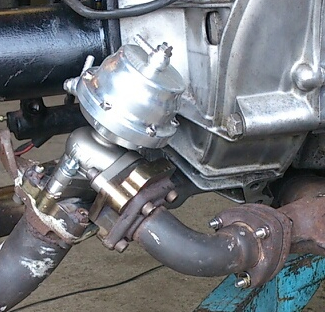Indi9xx
New member
A sad effect of turbo charged cars is that you get more exhaust pressure pre turbo, than you do post turbo, in the OE Wastegate you can suffer from the pounds per square inch behind the valve helping it open, so the reversed valve direction of a TiAL (Valve pulling in) is that the back pressure before the wastegate is helping keep it closed.
The main benefit of a proper dual port wastegate, like a TiAL, is that you have two ports either side of a diaphragm, one side to close or keep the wastegate closed, and on the other side a port to open it.
However in most traditional dual port mode plumbing of a MBC or EBC the pressure builds on both sides of the diaphragm until the target boost is achieved and then the boost on the "closing" side remains at that set pressure, while the "opening" side continues to rise which causes the valve to open.
One way of thinking about it is to imagine that either side of the diaphragm you have a balloon, if they both inflate to 18 psi, the diaphragm will be held tight, but as soon as one or other has 19 psi, there will be 1 psi more on one side so the diaphragm will move away from that pressure... the higher the target boost level, the more firmly the wastegate will be held in its closed state.
When you compare that to a single port wastegate, which with even a boost enhancer or improver, will have no pressure either side of the diaphragm until the target is reached, and then will have pressure in the opening side.
In the OE with BoostImprover method, you end up with pressure building higher and higher pre turbo, which then begins to open the valve in the wastagate, and as the BoostImprovers are static (set to one pressure) that increasing force trying to open the wastegate via the valve, causes the boost to decrease as RPM (and pre turbo back pressure) increases.
So, you always get a faster spool up (especially mid way between no boost and full boost onwards) and boost which holds on further through the rev range.. All bar other factors and restrictions of course.
The main benefit of a proper dual port wastegate, like a TiAL, is that you have two ports either side of a diaphragm, one side to close or keep the wastegate closed, and on the other side a port to open it.
However in most traditional dual port mode plumbing of a MBC or EBC the pressure builds on both sides of the diaphragm until the target boost is achieved and then the boost on the "closing" side remains at that set pressure, while the "opening" side continues to rise which causes the valve to open.
One way of thinking about it is to imagine that either side of the diaphragm you have a balloon, if they both inflate to 18 psi, the diaphragm will be held tight, but as soon as one or other has 19 psi, there will be 1 psi more on one side so the diaphragm will move away from that pressure... the higher the target boost level, the more firmly the wastegate will be held in its closed state.
When you compare that to a single port wastegate, which with even a boost enhancer or improver, will have no pressure either side of the diaphragm until the target is reached, and then will have pressure in the opening side.
In the OE with BoostImprover method, you end up with pressure building higher and higher pre turbo, which then begins to open the valve in the wastagate, and as the BoostImprovers are static (set to one pressure) that increasing force trying to open the wastegate via the valve, causes the boost to decrease as RPM (and pre turbo back pressure) increases.
So, you always get a faster spool up (especially mid way between no boost and full boost onwards) and boost which holds on further through the rev range.. All bar other factors and restrictions of course.










